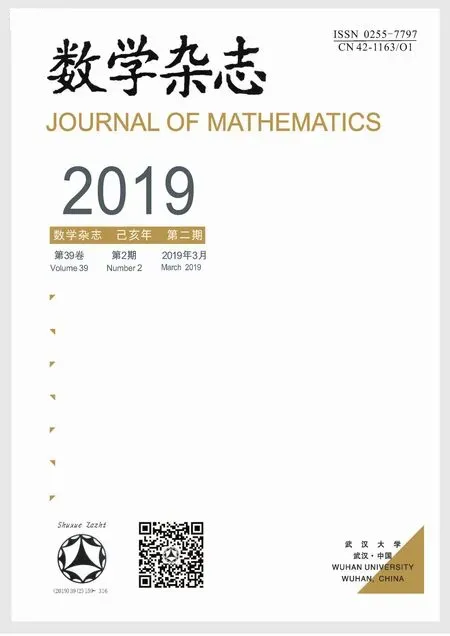A LIMINF RESULT FOR LéVY’S MODULUS OF CONTINUITY OF A FRACTIONAL BROWNIAN MOTION
LIU Yong-hong,WANG Wei-na
(School of Mathematics and Computing Science,Guilin University of Electronic Technology;Guangxi Colleges and Universities Key Laboratory of Data Analysis and Computation,Guilin 541004,China)
Abstract:In this paper,we investigate functional limit for Lévy’s modulus of continuity of a fractional Brownian motion.By using large deviation and small deviation for Brownian motion,a liminf for Lévy’s modulus of continuity of a fractional Brownian motion is obtained,which extends the corresponding result of Brownian motion.
Keywords: fractional Brownian motion;Lévy’s modulus of continuity;liminf result
1 Introduction and Main Result
Let{X(t);t ≥ 0}be a standard α-fractional Brownian motion with 0< α <1 and X(0)=0.The{X(t);t≥0}has a covariance function

for s,t≥0,and representation

where

{X(t);t≥ 0}has stationary increments with E(X(s+t)?X(s))2=t2α,s,t≥ 0 and is a standard Brownian motion when
Let C0[0,1]be the space of continuous functions from[0,1]to R with value zero at the origin,endowed with usual normand

Then H is a Hilbert space with respect to the scalar product

Define a mapping I:C0[0,1]→ [0,∞]by

The limit set associated with functional laws of the iterated logarithm for{X(t);t≥0}is Kα,the subset of functions in C0[0,1]with the form

here the function g(x)ranges over the unit ball of L2(R1),and hence.The subset K of C0[0,1]is defined by

For 0 In[1],Monrad and Rootzén gave a Chung’s functional law of the iterated logarithm for fractional Brownian motion,as follows,for any f∈K,hf,fi<1, where γ(f)is a constant satifying 2?1/2cα(1 ? hf,fi)?α≤ γ(f) ≤ 2?1/2Cα(1 ? hf,fi)?α,c,C denote the positive constants in(2.13)of[1]. Inspired by the arguments of Monrad and Rootzén,in the present paper,we obtain a liminf result for Lévy’s modulus of continuity of a fractional Brownian motion.The main result is stated as follows. Theorem 1.1 For each f∈K with hf,fi<1,then where b(f)is a constant satisfying here c and C denote the positive constants in(2.13)of[1]. Our proofs are based on the following lemmas. In order to prove(3.1)below,we need the following Lemma 2.1. Lemma 2.1(see(3.14)of[2])Let{X(t);t≥0}be fractional Brownian motion as above,σ2(u)=E(X(t+u)? X(t))2,we have that for any ε>0,there exists a positive constant k0=k0(ε)such that for any T,0 In order to prove(3.2)below,we need the following Lemma 2.2 and Lemma 2.3. Lemma 2.2(see Lemma 2.3 in[3])Let 0<α<1,0≤q0<1 and fix 0 where Ik=(skdk?1,skdr].Let 0< β there is a constant C0>0 depending only on α such that uniformly in t,u,k, Lemma 2.3 Let{Γ(t):t≥ 0}be a centred Gaussian process with stationary increments and Γ(0)=0.We assume that σ2(u)=E(Γ(t+u)? Γ(t))2.Let T>0,we have,for x large enough,any ε>0, where C1>0 is a constant. Proof This conclusion is from page 49 in[4]. We only need to show the following two claims: For any 0< ε<1,choose δ>0,such that.Then we have By Proposition 4.2 in[1],we have for any δ>0 and n large enough By Corollary 2.2 in[1], Choose d>(η? 1)?1,then which implies,by the Borel-Cantelli lemma, On the other hand,for any δ>0, By Lemma 2.1,we have that for any ε>0,there exists a positive k0=k0(ε)such that By the Borel-Cantelli lemma, By(3.3)–(3.5),we get Remark that hnis ultimately strictly decreasing to 0,so for any small h,there is a unique n such that h ∈ (hn+1,hn].Let,s∈[0,1],t∈[0,1].We define By the definition of in fimum,for any ε>0,there exists∈ (hn+1,hn]such that ξn≥ξ(h0n)? ε. Noting that By(3.6)–(3.9),we have Note that then it is sufficient to show that For r=1,2,3,···,we define for 0 ≤ t≤ 1,dr=rr+(1?γ),sr=r?r,0< γ <1.Then{Zr(·)},r=1,2,···are independent and where Yr(sr,·)is as in Lemma 2.2. In order to prove(3.10),we need to prove that for any ε>0, and First of all,we prove(3.15). Now using the argument as in Lemma 2.2,we have where q,δ are as in Lemma 2.2.For any ε>0,we have,by Lemma 2.3, Taking n sufficiently large such that,we get(3.15)by the definition of the sequence{hn:n≥1} Second,we prove(3.14). For any ε>0,choose δ>0,such that.Let β =2?1/2Cα(1 ? hf,fi)?α,then By Proposition 4.2 in[1],we have for any δ>0 and n large enough, By Corollary 2.2 in[1], Thus Similar to the proof of(3.15),we have the following estimate for I2,



2 Some Lemmas





3 The Proof of Theorem 1.1

3.1 The Proof of(3.1)















3.2 The Proof of(3.2)














